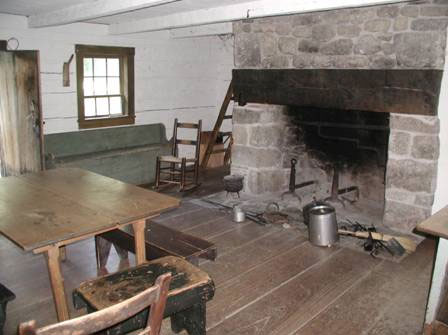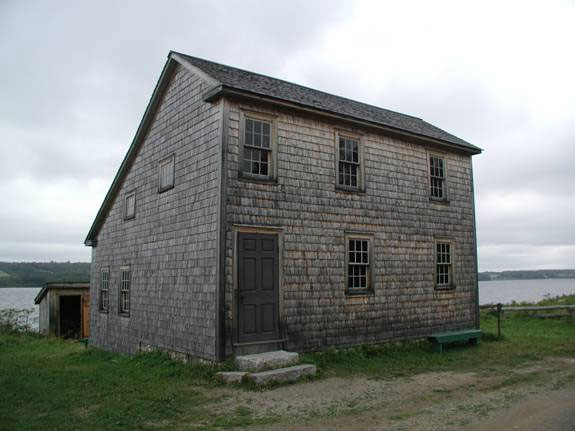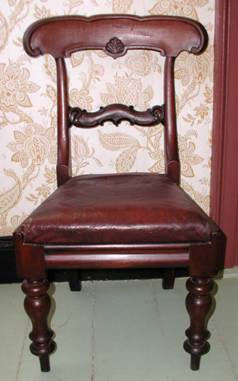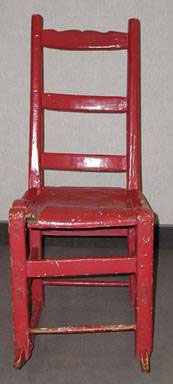Irish Homes and Furniture in New Brunswick
Material Historian
Kings Landing
Introduction
It has been said that of all the decorative arts, buildings and furniture reflect, more than any other, the values of the owners. Both of these decorative arts respond to climate conditions, geographic influences, economic and social conditions of a region and community.
The buildings built and used by Irish immigrants in New Brunswick tell us how quickly they responded to the local weather conditions and the abundance of local building materials. Their furniture reflects the cultural influences that they brought with them from the Old World.
Buildings
 Timothy Killeen Cabin c. 1825-1830, restored at Kings Landing
Timothy Killeen Cabin c. 1825-1830, restored at Kings Landing
When Irish emigrants landed in New Brunswick they were often given instructions on how to build a house. While they were used to stone structures in their homeland, the material most readily available in this province was wood. The instructions urged them to cut logs 22 feet in length for the sidewalls and 16 feet long for the end walls. It recommended building a stone fireplace in an end wall, using either stone for a mantel or hemlock as this wood was the most resistant to burning.
Timothy Killeen emigrated from Ireland with his wife in the early 1820s and eventually settled on a grant of land in Hanwell Settlement, several miles south of Fredericton, in Kingsclear Parish. He built a square log cabin which was moved to Kings Landing Historical Settlement in the 1960s and restored to 1830. It is the only Irish immigrant cabin to be restored in the province.
Timothy must have had a copy of these instructions for his cabin is constructed of thick logs that have been squared with a broadaxe and dovetails cut at the corners to hold it together. The exterior was covered in wooden shakes to protect the log structure from the winter elements. A stone fireplace with a wooden mantel was constructed at one end of the cabin for cooking and heat.
Photo at right: Interior of Timothy Killeen’s cabin restored at Kings Landing, note the square logs in the walls and stone fireplace on the end wall. Against the far wall, underneath one of the three windows in the cabin is a settle bed which served as a bench during the day and a bed at night.

 William Donaldson house restored to 1860 at Kings Landing
William Donaldson house restored to 1860 at Kings Landing
In the 1850s, William Donaldson and his family left their farm near Mactaquac approximately 10 miles west of Fredericton and moved into a saltbox style home on Westmorland Street in the capital city.
Donaldson was an Irish emigrant who had trained as a stonemason and had married the daughter of an Irish Lord and then came to New Brunswick in the 1830s. While this house had already been constructed in Fredericton and they moved into it in the 1850s, it is a good example of how Irish emigrants adapted to the familiar structures of New Brunswick.
The harsh winter conditions of New Brunswick and the abundant wood supply – often the logs cleared from their land formed the walls of their first cabin – meant that the Irish emigrant did not replicate his traditional home in this province.
Furniture

Chair – c. 1835. Kings Landing Collection M72.60.1
While Irish emigrants settling in this province did not reconstruct their traditional Irish houses, they did furnish their homes in familiar forms of furniture.
Photo at right: A chair made in Saint John using mahogany and birch by an Irish cabinetmaker, c. 1835. Kings Landing Collection M72.60.1
Among the thousands of Irish immigrants who came to New Brunswick in the 19th century were trained craftsmen, including cabinetmakers. These cabinetmakers found a ready market for their designs and products among the many Irish families that settled throughout this province.
In the Ingraham House dining room at Kings Landing there is a set of four chairs, M72.60.1, that are made of mahogany and birch, woods frequently used by cabinetmakers in Saint John and Fredericton, which are identical to formal chairs made in Dublin in the early 19th century. These chairs were made by an Irish trained cabinetmaker in Saint John, N.B., circa 1835.
As cabinetmakers came from Ireland, so too, did carpenters who made vernacular or country furniture, in the forms with which they were familiar. Charles Moffitt, 1821-1906, came from Ulster, Ireland on the ship Lady Caroline, in 1846 and settled in Fredericton where he enjoyed a prosperous career as a house carpenter. The wardrobe, M97.3.91, he built for his own home in Fredericton.
Photo at left: Wardrobe made by Charles Moffitt who emigrated from Ireland to Fredericton, New Brunswick in 1845. Kings Landing collections M97.3.
Other carpenters made furniture throughout rural New Brunswick. The blanket chest, M97.14.1, found on the Kingston peninsula, Kings County, exhibits many typical Irish vernacular decorations. The side columns on the front of this chest have diagonal reeding and oval lounges carved into the piece, and there are carved diamond forms across the front of the chest. All these forms of decoration are found on many examples of vernacular furniture in Ireland.

Kings Landing collections M97.3.91


Many Irish immigrants to New Brunswick were used to small cottages and furniture that could either serve two purposes, such as the settle bed in the Killeen Cabin, or be folded up out of the way during the day. The bed, M97.30.1, is an example of a bed which could be folded up out of the way during the day. There are six legs which support the bed. One set of legs is positioned about a foot from the headboard. The side rails are hinged just beyond this set of legs and the whole bed can be folded up to rest on these legs and the headboard posts. In a small cottage or cabin, the bed could be folded up to allow other work to go on during the day and then folded down for sleeping.

In the 1830s or 1840s Garrett Currie made furniture for his farmhouse near Mactaquac, N.B., 10 miles west of Fredericton. One of the chairs that he made had square posts on the back and front, square stretchers with through tenons, and three slats in the back of the chair. The seat was a board seat. The form is very similar to Irish sugan chairs, a small chair with square posts and a seat made out of woven hay or grass. Garrett Currie, though, was not born in Ireland. He was the son of Joshua Currie, 1790-1869. Joshua emigrated from Ireland in the early 19th century and established a farm in the Mactaquac area. Garrett was born in New Brunswick but when he made furniture he made what he was familiar with – Irish furniture similar to what his father would have had in his home.
Conclusion
As you walk through Kings Landing Historical Settlement you will encounter Irish culture and heritage around every corner. It is a rich legacy that has been passed down through generations and is now shared with thousands of people every year.

